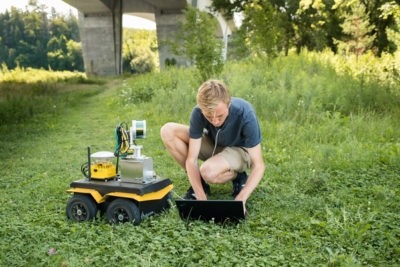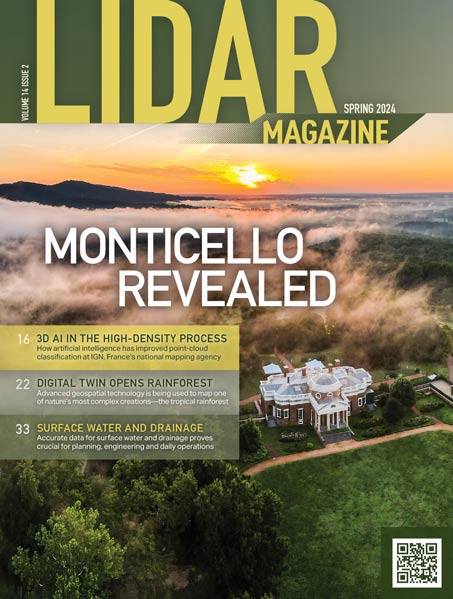
Stephen Phillips, a PhD student at the University of Waterloo, works with a robotic ground vehicle used in research on automating bridge inspections. Photo: Christopher Bogdon, Clearpath Robotics
Thursday, July 11, 2019 – Powerful robotics technology developed by researchers at the University of Waterloo makes critical bridge inspections cheaper and more reliable by automating the process.
The new system combines autonomous robots, cameras and lidar – a remote sensing method using lasers — to systematically collect data for defect detection and analysis.
“We can do more than humans now do – and do it much better in every way,” said Sriram Narasimhan, an engineering professor at Waterloo. “It is very inexpensive because you don’t need as many inspectors relying on specialized equipment such as lifts and you get much higher quality information.”
The vast majority of routine tasks during bridge inspections, which are required every few years by regulatory authorities to ensure safety, are done visually by inspectors.
Narasimhan, a Canada Research Chair in Smart Infrastructure, said current practices create an inspection system that is subjective, less repeatable and often imprecise because it is based, at least in part, on educated guesswork.
The automated system, by contrast, eliminates the subjectivity of human inspectors, and is both repeatable and reliable, with the ability to precisely measure the size of defects and reveal invisible, sub-surface problems with infrared cameras.
It is designed so that the results from one inspection can be overlaid on previous inspection results on a detailed map displaying dozens of key vulnerable areas of the subject bridge.
“The benefit is that we can track and quantify defects as they evolve over time,” said Narasimhan, director of the Structural Dynamics Identification and Control Laboratory. “That is not practically possible with humans alone, but it is with the assistance of robots.”
A wheeled ground vehicle used in the research was programmed with an inspection plan detailing instructions on its location and areas of the bridge to focus on.
The same software could also be used for inspections with water-going vehicles and airborne drones, or to inspect other infrastructure such as nuclear power plants and buildings.
Researchers are now developing water-borne inspection platforms and artificial intelligence algorithms to automatically detect and identify particular kinds of defects.
Further down the road, they hope to automate analysis of the data collected by robots to much more accurately assess the structural integrity of infrastructure and forecast the need for repairs or replacement.
“We’re combining our infrastructure expertise with the latest robotics technology to greatly improve what is now a very manual inspection process,” Narasimhan said.
A paper on the research, Automating Data Collection for Robotic Bridge Inspections, appears in the Journal of Bridge Engineering.
For more information about engineering research at the University of Waterloo, please visit: https://uwaterloo.ca/waterloo-engineering-research/
